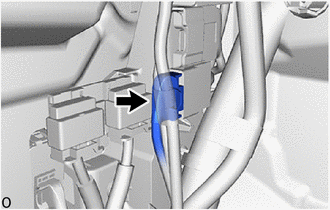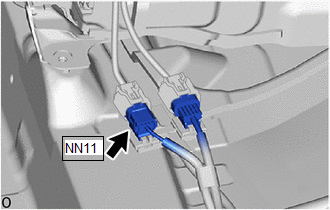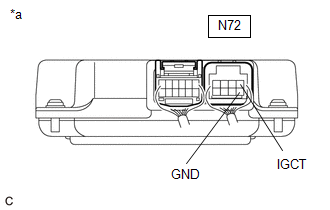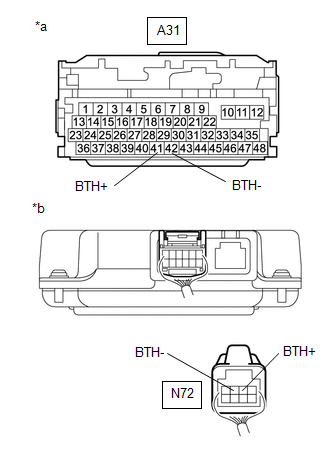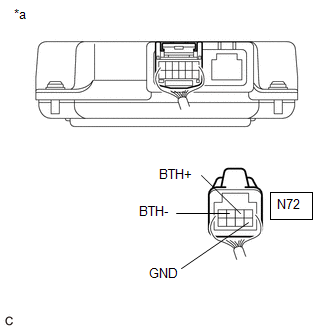| Last Modified: 01-30-2024 | 6.11:8.1.0 | Doc ID: RM100000001PE9M |
| Model Year Start: 2020 | Model: RAV4 HV | Prod Date Range: [06/2020 - 08/2020] |
| Title: HYBRID / BATTERY CONTROL: HYBRID CONTROL SYSTEM (for 2WD with NICKEL METAL HYDRIDE BATTERY): U029A87; Lost Communication with Hybrid/EV Battery Sensor Module Missing Message; 2020 MY RAV4 HV [06/2020 - 08/2020] | ||
|
DTC |
U029A87 |
Lost Communication with Hybrid/EV Battery Sensor Module Missing Message |
DESCRIPTION
The battery voltage sensor detects the HV battery conditions (voltage, current and temperature) and the battery cooling fan frequency, and sends the detected signals to the hybrid vehicle control ECU assembly via serial communication. (The hybrid vehicle control ECU assembly does not send signals to the battery voltage sensor.)
|
DTC No. |
Detection Item |
DTC Detection Condition |
Trouble Area |
MIL |
Warning Indicate |
|---|---|---|---|---|---|
|
U029A87 |
Lost Communication with Hybrid/EV Battery Sensor Module Missing Message |
Serial communication error between the hybrid vehicle control ECU assembly and battery voltage sensor: The hybrid vehicle control ECU assembly cannot receive signals from the battery voltage sensor correctly. (1 trip detection logic) |
|
Comes on |
Master Warning: Comes on |
CONFIRMATION DRIVING PATTERN
HINT:
After repair has been completed, clear the DTC and then check that the vehicle has returned to normal by performing the following All Readiness check procedure.
- Connect the Techstream to the DLC3.
- Turn the power switch on (IG) and turn the Techstream on.
- Clear the DTCs (even if no DTCs are stored, perform the clear DTC procedure).
- Turn the power switch off and wait for 2 minutes or more.
- Turn the power switch on (IG) and turn the Techstream on.
- With power switch on (IG) and wait for 2 minutes or more.
- Enter the following menus: Powertrain / Hybrid Control / Utility / All Readiness.
-
Check the DTC judgment result.
HINT:
- If the judgment result shows NORMAL, the system is normal.
- If the judgment result shows ABNORMAL, the system has a malfunction.
- If the judgment result shows INCOMPLETE, perform driving pattern again.
WIRING DIAGRAM
Refer to the wiring diagram for DTC P0AFC00.
CAUTION / NOTICE / HINT
CAUTION:
- Before inspecting the high-voltage system, take safety precautions to prevent electrical shocks, such as wearing insulated gloves and removing the service plug grip. After removing the service plug grip, put it in your pocket to prevent other technicians from accidentally reconnecting it while you are working on the high-voltage system.
-
After removing the service plug grip, wait for at least 10 minutes before touching any of the high-voltage connectors or terminals. After waiting for 10 minutes, check the voltage at the terminals in the inspection point in the inverter with converter assembly. The voltage should be 0 V before beginning work.
HINT:
Waiting for at least 10 minutes is required to discharge the high-voltage capacitor inside the inverter with converter assembly.
NOTICE:
After turning the power switch off, waiting time may be required before disconnecting the cable from the negative (-) auxiliary battery terminal. Therefore, make sure to read the disconnecting the cable from the negative (-) auxiliary battery terminal notices before proceeding with work.
PROCEDURE
|
1. |
CHECK DTC OUTPUT (HYBRID CONTROL) |
(a) Connect the Techstream to the DLC3.
(b) Turn the power switch on (IG).
(c) Enter the following menus: Powertrain / Hybrid Control / Trouble Codes.
(d) Check and record any HV system DTCs and freeze frame data. Check for DTCs.
Powertrain > Hybrid Control > Trouble Codes
|
Result |
Proceed to |
|---|---|
|
Only "U029A87" is output. |
A |
|
DTCs other than "U029A87" are also output. |
B |
(e) Turn the power switch off.
| B |

|
|
|
2. |
CHECK CONNECTOR CONNECTION CONDITION (INTERMEDIATE CONNECTOR) |
|
(a) Check that the AN2 intermediate connector which connects the battery voltage sensor to the hybrid vehicle control ECU is securely connected with no deformation, and that there is no contamination by water or foreign matter. HINT: For vehicles in which the intermediate connector is inside the relay block, check for signs of water intrusion inside the relay block. OK: - The connector is connected securely. - The terminals are not deformed and are connected securely. - No water or foreign matter in the connectors. |
|
|
Result |
Proceed to |
|---|---|
|
OK |
A |
|
NG (The connector is not connected securely.) |
B |
|
NG (The terminals are not making secure contact or are deformed, or water or foreign matter exists in the connector.) |
C |
| B |

|
CONNECT SECURELY |
| C |

|
REPAIR OR REPLACE HARNESS OR CONNECTOR |
|
|
3. |
CHECK CONNECTOR CONNECTION CONDITION (INTERMEDIATE CONNECTOR) |
|
(a) Check that the NN11 intermediate connector which connects the battery voltage sensor to the hybrid vehicle control ECU is securely connected with no deformation, and that there is no contamination by water or foreign matter. HINT: For vehicles in which the intermediate connector is inside the relay block, check for signs of water intrusion inside the relay block. OK: - The connector is connected securely. - The terminals are not deformed and are connected securely. - No water or foreign matter in the connectors. |
|
|
Result |
Proceed to |
|---|---|
|
OK |
A |
|
NG (The connector is not connected securely.) |
B |
|
NG (The terminals are not making secure contact or are deformed, or water or foreign matter exists in the connector.) |
C |
| B |

|
CONNECT SECURELY |
| C |

|
REPAIR OR REPLACE HARNESS OR CONNECTOR |
|
|
4. |
CHECK BATTERY VOLTAGE SENSOR (IGCT VOLTAGE) |
CAUTION:
Be sure to wear insulated gloves.
(a) Check that the service plug grip is not installed.
NOTICE:
After removing the service plug grip, do not turn the power switch on (READY), unless instructed by the repair manual because this may cause a malfunction.
(b) Remove the No. 1 hybrid battery exhaust duct.
(c) Connect the cable to the negative (-) auxiliary battery terminal.
(d) Turn the power switch on (IG).
|
(e) Measure the voltage according to the value(s) in the table below. Standard Voltage:
NOTICE: Turning the power switch on (IG) with the service plug grip removed causes other DTCs to be stored. Clear the DTCs after performing this inspection. HINT: As there might be an intermittent malfunction in the battery voltage sensor power source circuit, inspect the following even if the measured voltage is as specified:
|
|
(f) Turn the power switch off.
(g) Disconnect the cable from the negative (-) auxiliary battery terminal.
(h) Install the No. 1 hybrid battery exhaust duct.
| NG |

|
REPAIR OR REPLACE HARNESS OR CONNECTOR (BATTERY VOLTAGE SENSOR POWER SOURCE CIRCUIT) |
|
|
5. |
CHECK HARNESS AND CONNECTOR (HYBRID VEHICLE CONTROL ECU ASSEMBLY - BATTERY VOLTAGE SENSOR) |
CAUTION:
Be sure to wear insulated gloves.
(a) Check that the service plug grip is not installed.
NOTICE:
After removing the service plug grip, do not turn the power switch on (READY), unless instructed by the repair manual because this may cause a malfunction.
(b) Disconnect the A31 hybrid vehicle control ECU assembly connector.
NOTICE:
- Before disconnecting the connector, check that it is not loose or disconnected.
- Check that each connector between the hybrid vehicle control ECU assembly and battery voltage sensor is not loose or disconnected.
(c) Remove the No. 1 hybrid battery exhaust duct.
(d) Disconnect the N72 battery voltage sensor connector.
NOTICE:
- Before disconnecting the connector, check that it is not loose or disconnected.
- Check the terminals of the connector for deformation and corrosion.
|
(e) Measure the resistance according to the value(s) in the table below. Standard Resistance:
NOTICE: Make sure that each connector between the battery voltage sensor and hybrid vehicle control ECU assembly is not loose or disconnected and its terminals are not deformed or corroded. |
|
(f) Connect the cable to the negative (-) auxiliary battery terminal.
(g) Turn the power switch on (IG).
(h) Measure the voltage according to the value(s) in the table below.
Standard Voltage:
|
Tester Connection |
Condition |
Specified Condition |
|---|---|---|
|
A31-41 (BTH+) - Body ground |
Power switch on (IG) |
Below 1 V |
|
A31-42 (BTH-) - Body ground |
Power switch on (IG) |
Below 1 V |
NOTICE:
- Turning the power switch on (IG) with the service plug grip removed causes other DTCs to be stored. Clear the DTCs after performing this inspection.
- If the power switch is turned on (IG) with the connectors disconnected, other DTCs will be stored. Be sure to clear the DTCs after the inspection.
(i) Turn the power switch off.
(j) Disconnect the cable from the negative (-) auxiliary battery terminal.
(k) Reconnect the N72 battery voltage sensor connector.
(l) Install the No. 1 hybrid battery exhaust duct.
(m) Reconnect the A31 hybrid vehicle control ECU assembly connector.
| NG |

|
REPAIR OR REPLACE HARNESS OR CONNECTOR |
|
|
6. |
CHECK HYBRID VEHICLE CONTROL ECU ASSEMBLY |
CAUTION:
Be sure to wear insulated gloves.
(a) Check that the service plug grip is not installed.
NOTICE:
After removing the service plug grip, do not turn the power switch on (READY), unless instructed by the repair manual because this may cause a malfunction.
(b) Remove the No. 1 hybrid battery exhaust duct.
(c) Disconnect the N72 battery voltage sensor connector.
NOTICE:
Before disconnecting the connector, check that it is not loose or disconnected.
(d) Connect the cable to the negative (-) auxiliary battery terminal.
(e) Turn the power switch on (IG).
|
(f) Measure the voltage according to the value(s) in the table below. Standard Voltage:
NOTICE:
|
|
(g) Turn the power switch off.
(h) Disconnect the cable from the negative (-) auxiliary battery terminal.
(i) Measure the resistance according to the value(s) in the table below.
Standard Resistance:
|
Tester Connection |
Condition |
Specified Condition |
|---|---|---|
|
N72-2 (BTH+) - N72-3 (BTH-) |
Power switch off |
4.4 to 5.4 kΩ |
HINT:
The resistance will be 2.0 kΩ or less if there is an internal short in the hybrid vehicle control ECU assembly.
(j) Reconnect the N72 battery voltage sensor connector.
(k) Install the No. 1 hybrid battery exhaust duct.
| OK |

|
| NG |

|
|
|
|
![2019 - 2020 MY RAV4 HV [11/2018 - 08/2020]; HYBRID / BATTERY CONTROL: HYBRID CONTROL SYSTEM (for 2WD with NICKEL METAL HYDRIDE BATTERY): UTILITY](/t3Portal/stylegraphics/info.gif)

